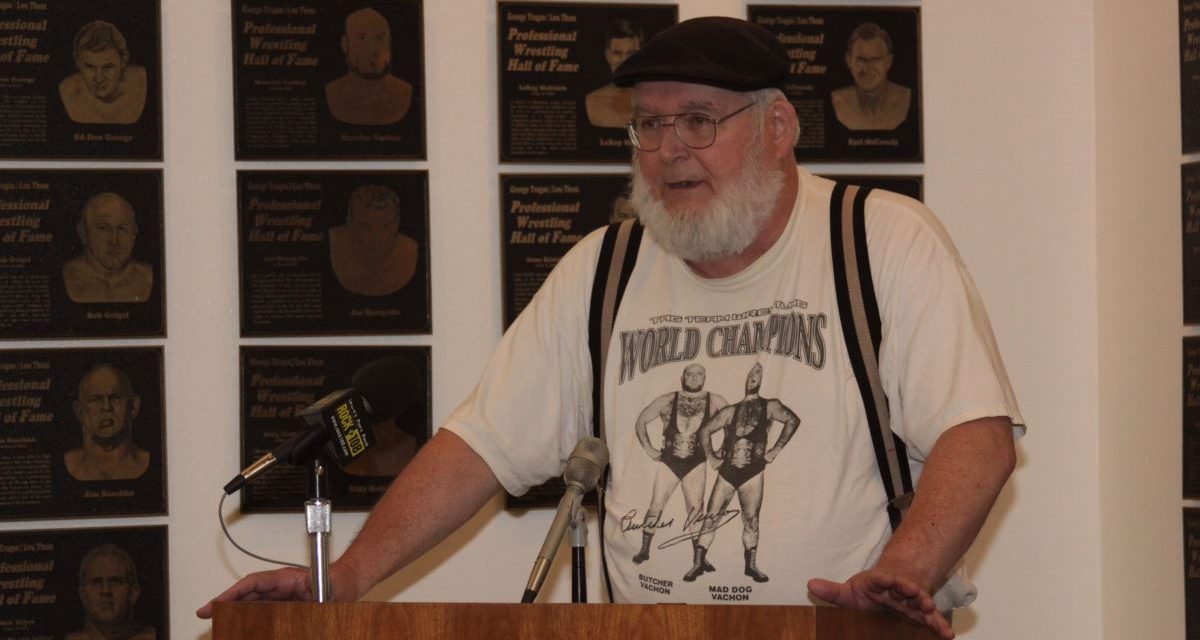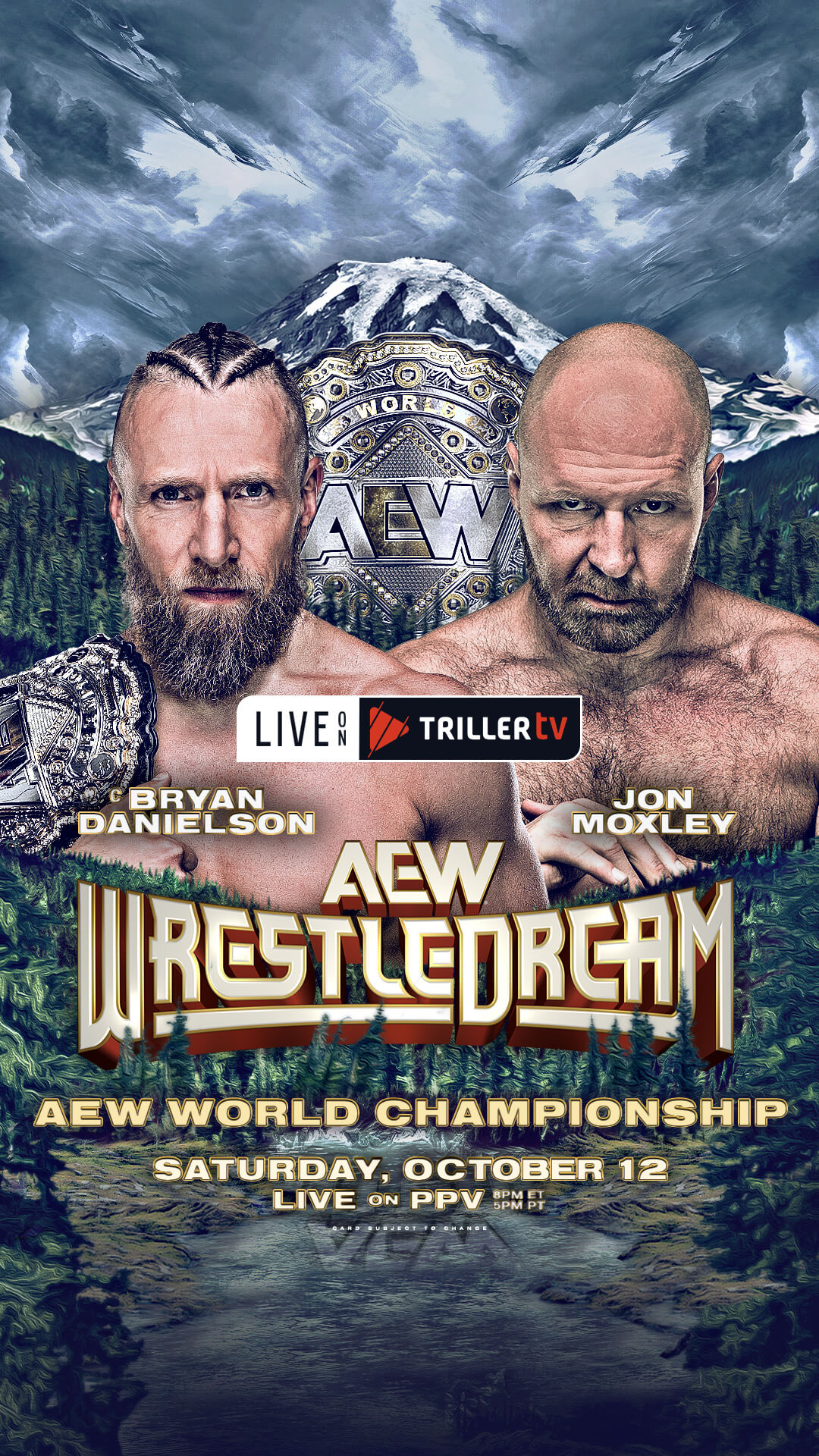If you combined Falstaff, Hemingway, and Gus the Wrestling Bear, you might just start to capture some of the essence of J Michael Kenyon.
Just some of the essence, mind you, because they never drunkenly drove a car into San Diego’s Mission Bay, changed their names to suit a woman, or spent hours sleuthing that it was Wayne Barnett, not Barrett, who wrestled at Turner Hall in Alton, Illinois, in January 1945.
“He has led an existence heavy on the theatrical and at times the haphazard, often becoming a better story than the one he was writing,” Seattle sportswriter Dan Raley quipped in a 2007 profile.
So while Kenyon died May 3, 2017, at 73, his lifelong pursuit of wine, women, and wrestling ensures that he will remain as vivid in the afterlife as he was when he was swapping vasectomy stories with “Shag” Thomas, his first wrestling idol.
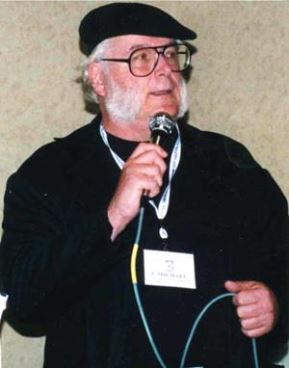
J Michael Kenyon
As Dean Silverstone, his friend of more than half a century, wrote in I Ain’t No Pig Farmer!: “To the average Joe who has not been involved in wrestling, Kenyon’s life would appear extremely odd, but to an old carny such as myself, he’s just a decent, normal, fun-loving friend.”
Living in Port Orford on the southern Oregon coast, Kenyon had not been well for years, suffering from congestive heart failure and a variety of other maladies. Health issues never deterred him from cranking out novella-length emails of obscure wrestlers and results, opining on the oddities of Civil War General Daniel Sickles, or making corrections to the record in his self-appointed role as the Wrestling Spelling Police.
Even in death, he was hard to pin down. KIRO, a Seattle TV station, reported that he died April 26 at his home. That date was a surprise to his legion of friends who received an April 28 email from him about 1954 wresting results in Jackson, Tennessee.
“We just exchanged emails last week. He warned me that the Wrestling Spelling Police may be paying me a visit over my Honolulu research,” said Mark Hewitt, author of Catch Wrestling: A Wild and Wooly Look at the Early Days of Pro Wrestling in America. “J Michael was the keeper of the chronicles and could always be depended on for help.”
“I met him in 2013, through emails. We never spoke directly, but I considered him a great friend,” said Mike Zim, son of “Wild” Bill Zim. “He was the one who inspired me to research dad’s wrestling history. That quickly reached into all kinds of topics, since he was such a Renaissance man. Baseball, basketball, movies, history, politics, newspapering, radio, thunder boats, horse racing.”
The Seattle Mariners expressed their condolences to Kenyon, who covered the team from its inaugural season in 1977 through 1981. “He was a colorful personality, who had a photographic memory and loved baseball, professional wrestling, golf and the game of croquette and the game of life,” the team’s publicity department said in a statement May 7.
“Now that he is gone, who do I discuss some forgotten undercard wrestler of the 1930s that no one else where heard of? We were always asking each other about various ring names. Could this guy be this wrestler?” said Don Luce, whom Kenyon considered a wrestling researcher without peer. “Now that he is gone, there is no one else to replace his knowledge of wrestling, sports, and various other topics.”
The Budding Author
Michael Eugene Glover was born July 9, 1943 in Seattle, the son of a postal carrier who loved the ponies. He described his father Lester as “painfully shy.” When colleagues gave the senior Glover a going-away present following a half-century of selling pari-mutuel tickets at the Longacres Race Track in Seattle, all he could say was, “Gee, this is swell.”
His son had no such inhibitions. He was well into his literary career as a teenager, selling ads for the Roosevelt High School yearbook in Seattle, poring over newspapers at which he’d eventually work, and writing fan letters to sportswriter W.C. “Bill” Heinz, author of The Professional, a boxing novel.
“The way I remember it, I read The Professional when it came out in January 1958, and for the first time in my life wrote to the author to tell him how much I liked his book,” Kenyon recalled. “I must have taken months to work up the nerve, because the reply from Bill Heinz, which came within a few days, was dated October 11, 1958, my birthday.”
Though he was only 16, Kenyon had been tinkering with writing westerns, and the lessons Heinz imparted about character development influenced everything he did from then on. Characters, Heinz explained, must be permitted to think for themselves, each with his own manner of speech and level of thought. The writer should not tell, but show.
“You cannot imagine how important it was for me to learn these unwritten rules of writing. I had been writing fiction, Westerns, for only the past seven years. I knew I didn’t want to write in the classic style of the omniscient author. I didn’t have the voice for it, the language. Studying Hemingway, I felt I was getting close to the style I wanted to develop. I began reading The Professional and there it was on every page,” Kenyon recalled.
At the same time he was learning to write, Kenyon was falling under the spell of Harry Elliott’s Seattle wrestling promotion—in typical Kenyonesque prose, he said he found himself “gobsmacked” by the wondrous world of pro wrestling. In particular, he was captivated with James “Shag” Thomas, the short, squat ex-Ohio State football player who was touring the Northwest because opportunities for black wrestlers were too few and far between.
In 1960, at about the time Thomas was executing a turn from heel to hero in a feud with Tony Borne, Kenyon summoned the courage to approach the wrestler and ask permission to run a fan club.
“‘No,’ he said, sizing me up (as I had reached my full height of six-foot-four, that meant his head was tilted up at a rather severe angle), and laughing about the Mutt and Jeff aspect of our heights. Almost instantly, we seemed to connect on some level … he asked about me, about where I lived, went to school, how long I’d been a wrestling fan, etc. … and before I knew it, he’d agreed to let me launch a fan club in his honor,” Kenyon said.
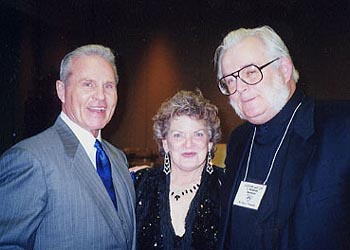
Paul Diamond, and J Michael Kenyon with his wife Joan at a Cauliflower Alley Club reunion. Photo by Rose Diamond
Outside of relatives, Thomas was the first adult who befriended Kenyon, and he became a confidant of sorts for the 17-year-old boy. “Shag was such an influence on me! Even to the point, I must admit, that I followed his lead … albeit years later … when I got a vasectomy. I’ll never forget the night I huddled with him prior to a show in Seattle’s Eagles Auditorium (must have been sometime late in the fall of 1961) and, when I asked him why he seemed to be walking a little more slowly than usual, he explained, in some detail, the surgical procedure he had undergone that very afternoon. And, with a shrug, he went right into the ring and participated in a slam-bang, 30-minute wrestling match. ‘Can’t afford not to work,’ he said, with the friendly smile he always seemed to have for me.”
New Lines of Work
For two dollars, Kenyon — still lanky Mike Glover at the time — turned over the reins of the Thomas fan club to Silverstone, three years his junior, as he went into the Army in Texas. Upon exiting, the father of his first wife Trudi — a serial groom, Kenyon would have five brides — tried to entice him into a lucrative screw machine products business that claimed aerospace giant Boeing as one of its clients.
It wasn’t in character for Kenyon. “When confronted with the choice of standing in front of a lathe or sitting in front of a typewriter propped up at the end of the nearest saloon bar, I opted for the latter,” Kenyon said. He would work for Washington newspapers in Yakima, Tacoma, and Seattle, among others, By his own count, he was fired and rehired four times between 1965 and 1980 at the Post-Intelligencer, where his beat at the ripe old age of 23 included the first year of the NBA Seattle Supersonics in 1967-68.
But wrestling was never far from his mind. In 1966, he and Silverstone hooked up to form Western State Wrestling, a promotion that would run Port Angeles, Washington, every other Thursday night. On the afternoon of the third show, in October, Silverstone swung by Kenyon’s house. His business partner sheepishly walked out, still in his pajamas. “My wife won’t let me go. We haven’t made any money and she doesn’t think we will.”
How could such a marriage last? Answer: it couldn’t. Kenyon became smitten with Lee Franke, a woman he met at a Seattle pub, quit the Seattle paper for one in Baltimore, and changed his identity to get married in June 1968. He spotted the Kenyon Printing Co. when he was driving through Lynnwood, Washington, and thought it would be a dandy last name. He put a “J” in front — no period — and declared himself to be J Michael Kenyon. Bill McFarland handled the legal aspects of the name change; he was a 315-goal scorer in the old Western Hockey League and one-time president of the World Hockey Association.
“His nickname was ‘Packy’ and that’s what I called him when he played and when I handed over his fee, one U.S. Grant ($50), on the day a Superior Court judge in Seattle said, ‘Have a nice life, Mister Kenyon.’ ” Perhaps not coincidentally, Kenyon nee Glover left his love of hockey behind with his name change. Once a front-row customer of the Seattle Ironmen and Americans in the 1950s, he soured on the sport when players started wearing helmets. “When I followed the game, the only guys who wore hats were the ones who already had metal screws fitted into their brain sacs,” he fumed.
Loving Instability
The marriage to Lee didn’t last long, and Kenyon was disappointed to find the Baltimore Evening Sun‘s narrow columns rendered his byline as “Mike Kenyon.” By 1970, he had morphed into a boxing entrepreneur in Ohio, with Dean Chance, a former Cy Young Award winner known as one of baseball’s freest spirits. Then with the Cleveland Indians, Chance hired Kenyon as matchmaker and publicity guru for his budding boxing business. The idea was to create a year-long, $250,000 program that would produce boxing shows in Canton, Akron, and Youngstown. “I’m amazed at the reception we’ve received in the area,” Kenyon told the Akron Beacon-Journal. “Ninety-five percent of the people we’ve talked to are tremendously enthused about our plans and many are non-boxing people.”
The gig spanned two months before the peripatetic Kenyon was on the road again, reviewing films for the Hollywood Reporter. At various points in his career, he’d promote horse racing, croquet, basketball, rodeo shows, and serve as spokesman for the United Hydroplane Racing Association. Some ventures ended badly; others ended even worse. As an editor at a California newspaper during the height of Watergate, he was canned for running a front-page picture of President Richard Nixon with the cutline: “Would you buy a used car from him now?”
Yet all roads led back to Seattle, and when the Mariners entered the American League as a not-very-good expansion team in 1977, Kenyon was back at the Post-Intelligencer as their beat writer. The reason was simple: the man could write. All those lessons from Heinz and Hemingway stuck with him even during his excursions into risky businesses. In his daily stories, there was no dry recitation of facts and figures. He always approached his subject sideways, as in his lead to a 1978 piece about a Minnesota Twins-Mariners game:
“Within Gene Mauch’s right shoe, sans tongue and laces, an inflamed foot nearly as uncontrolled as his pitchers were last night. In the clubhouse, Mauch didn’t know which ached more — the foot or the 13-6 loss to the Seattle Mariners. In the air-conditioned Kingdome palace, there was nothing cool about the bats of either team. … There was nothing cool about Mauch’s right foot, either.”
“The P-I sports department in those days was a Jack Nicholson short of One Flew over the Cuckoo’s Nest,” wrote Seattle journalist Art Thiel. “I’ll never forget the informal competition between two of my writer heroes, J Michael Kenyon and Blaine Johnson. Known as ‘One for the Thumb,’ they raced to see who could be the first to a fifth marriage.”
Kenyon was one of the earliest sportswriters to branch into radio, hosting shows on KING and KVI in Seattle. At KING, he walked out in the middle of his show to protest a station manager’s interference. At KVI, which he joined in 1980, he planned to drop a marshmallow 280 feet from the top of the Kingdome in recognition of New York Yankee manager Billy Martin’s fistfight with a marshmallow salesman. American League President Lee McPhail vetoed the gimmick. When Woody Hayes was in Seattle for a clinic, Kenyon called in to the ex-Ohio State football coach to ask about a punching incident at the Gator Bowl that led to his dismissal. Hayes cursed and hung up on Kenyon.
“I personally believe the world of wrestling created his personality because, in real life, he acted like a heel worker,” Silverstone said. “If someone didn’t like what he did, he’d say ‘Screw you,’ and he’d move on.”
In fact, Kenyon aid one of his few regrets was choosing radio over newspaper work, instead of trying to find a way to accommodate both. “If I had to do it all over again, I’d argue harder to have the P-I let me do the newspaper and radio thing,” Kenyon told Raley in the 2007 profile. “I’d probably still be there.”
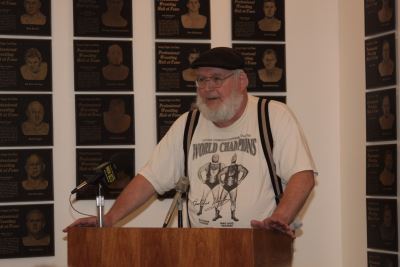
J Michael Kenyon receives the James C Melby Award in Waterloo, Iowa, at the George Tragos/Lou Thesz Professional Wrestling Hall of Fame. Photo by Wayne McCarty
The Dean of Wrestling History
Whatever his game, or his dame, for that matter, Kenyon always kept on top of wrestling history, poring over old newspapers and microfilms for clues to the business that so entranced him as a kid. He collected his musings, scribblings, and notes in “Wrestling As We Liked It,” aka the WAWLI papers, probably the single largest arcana collection of its kind. A typical rambling issue included clippings on a 1935 bans on soda bottles at wrestling events in Norfolk, Virginia, and aged results from Bridgeton, New Jersey, and Holyoke, Massachusetts. The carnival aspect of wrestling– midgets, sideshows, and bears — was a particular point of pleasure with Kenyon.
For years, his “Sunday Punches” column on the Cauliflower Alley Club website was the go-to place for memories of days gone by, since he didn’t have much use for wrestling post-1965.
“Boy, what I would give to have one more crack at watching the likes of Nomellini, Kiniski, the Torres brothers, Barend and Dubuque, Steve Stanlee, Bob Orton, Bobo Brazil and Lord Blears — all on one show, at a delightful old venue like the [San Francisco] Winterland, the converted ice skating rink at the corner of Post and Steiner,” he lamented.
Still, he updated CAC members on current topics such as Vince McMahon’s TV shows and the latest from wrestling journalist Dave Meltzer, who turned a lot of Kenyon’s research into mainstream articles.
“At one point around 1974, he asked me if we could do a newsletter together because his regular sports work made covering wrestling as detailed as he would like difficult,” Meltzer wrote upon Kenyon’s death. “As it turned out, he lost interest in furthering that within a few months, and would disappear and return to covering wrestling over the years. … Because of his background in promoting events, he had a combination of insider knowledge, trivial and historical knowledge of pro wrestling, and an understanding of the business as it was like nobody of his era.”
Kenyon had a hand in record books chronicling Gorgeous George, Jim Londos, Sandor Szabo, and others, and posted on wrestling message boards under the moniker “Old Fall Guy,” a tip of the hat to Marcus Griffin’s 1938 wrestling expose, The Fall Guys. But his most valuable contribution came in digital reams of behind-the-scenes correspondence, from a monograph on a wrestling swindle in 1919 to his talks with Myrtle Casey, the sister-in-law of former world champion Steve “Crusher” Casey. His resources informed every wrestling history book written in the last two decades. “Bloody” Buddy O’Brien was initially an afterthought in our book, The Pro Wrestling Hall of Fame: The Heels. By the time we tapped Kenyon’s reservoir of research, O’Brien was a featured section, and his family learned details about him they never knew.
In 2010, when he received the James Melby Award from the National Wresting Hall of Fame/Dan Gable Museum, Kenyon took a stab at explaining the history of wrestling research, taking care to credit his longtime allies in minutiae such as Tom Burke, Don Luce, Burt Ray, Steve Yohe, Mark Hewitt, and the late Fred Hornby.
“Like movie stars, lots of grapplers used made-up names to begin with — and then, to shroud the fact they were on losing streaks (“jobbers” in the parlance of the trade), they continued to change their names. My particular passion, for 55 years, has been trying to straighten out all those monikers.”
In recent years, Kenyon and Joan were pretty much confined to their home in Port Orford. They got an occasional visit from Al Bianchi, a friend of 50 years who coached the inaugural edition of the Supersonics. He was working with Kenyon on a book about the changing nature of basketball. “Along the way, I’ll be attempting to correct as many of the errors made by other pro cage historians whose research, here and there, proved a little faulty,” Kenyon said, who also may have been the world’s leading authority on the history of the Harlem Globetrotters.
Otherwise, the Kenyons were pretty much limited to the post office, the grocery store, and the library.
“Funny about being a ‘shut-in,'” he said. “When Harry Elliott cranked up what would become the halcyon years of Seattle wrestling promotion in 1959, his spiel to the TV audience at the top of the weekly (live) program on would always include a big hello and howdy to ‘those shut-ins at home across the Pacific Northwest.’
“Now, 53 years later, I’m just about a fully qualified member of the clan … But, as the Brits forever are reminding us: ‘musn’t grumble.’ And it’s true: I haven’t got the slightest kick in the world coming … I’ve had enough fun and good times for 10 lifetimes.”
Steven Johnson and Greg Oliver dedicated The Pro Wrestling Hall of Fame: Heroes & Icons to Kenyon and the wrestling research industry he spawned. There’s no way we can repay the debts we owe him, other than to continue to write about wrestling with honesty, humor, and a passion for the facts.
